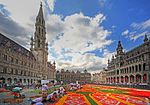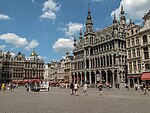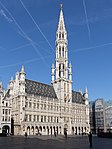Rue du Marché aux Fromages
City of BrusselsStreets in BrusselsUse British English from January 2022

The Rue du Marché aux Fromages (French) or Kaasmarkt (Dutch), meaning "Cheese Market Street", now also known by its nickname the Rue des Pittas or Pitastraat ("Pitta Street"), is a historic street in Brussels, Belgium, near the Grand Place (Brussels' main square). It is lined with numerous pitta bars, pizzerias and cocktail bars. Two blind alleys come from this street: the Impasse du Dragon/Draeckengang (currently the Impasse de la Poupée/Poppegang), and the Impasse du Poivre/Pepergang (now called the Impasse de la Cuve/Kuipgang).
Excerpt from the Wikipedia article Rue du Marché aux Fromages (License: CC BY-SA 3.0, Authors, Images).Rue du Marché aux Fromages
Impasse de la Cuve - Kuipgang, City of Brussels Pentagon (Brussels)
Geographical coordinates (GPS) Address Nearby Places Show on map
Geographical coordinates (GPS)
| Latitude | Longitude |
|---|---|
| N 50.845833333333 ° | E 4.3530555555556 ° |
Address
Mykonos
Impasse de la Cuve - Kuipgang
1000 City of Brussels, Pentagon (Brussels)
Belgium
Open on Google Maps











